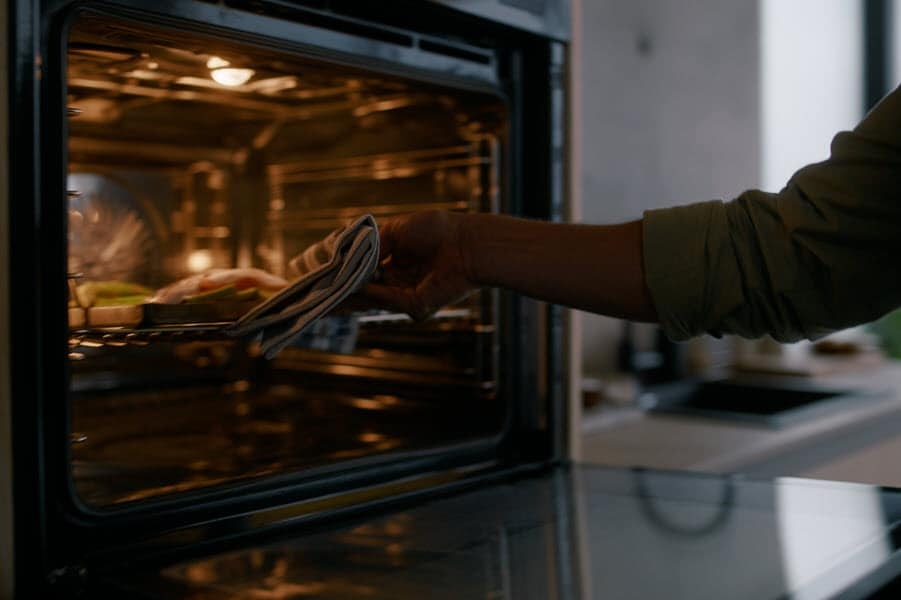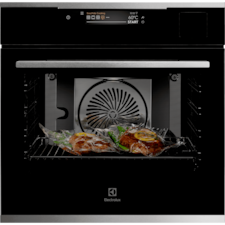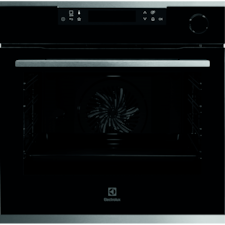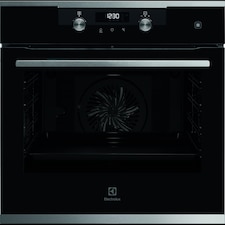Figuring out how to use your oven at home can be daunting. But in reality, it’s easier than you might think, as long as you keep a few basic things in mind. With this guide, Electrolux India will help you on your oven cooking journey.
Below are some basic steps you should know on how to use an oven:
You need to know what kind of oven you’re dealing with to be able to use it efficiently. There are several different types of ovens, and they need to be used in different ways. Here are the most important varieties:
Gas ovens use a gas-fuelled burner to cook your food. Gas is brought to the burner and ignited, and burns until the oven reaches the set temperature. The burner is then automatically turned off until the temperature lowers again. It then turns on to reach the set temperature again.
If your home already has a gas connection, gas ovens are relatively cheap to install and run, though they are notorious for their uneven heat distribution.
Electric ovens use electrically heated coils to cook the food. The coils heat up relatively slowly, but then keep a constant temperature more steadily than a gas oven can. While electric ovens can be more expensive to run, many people also find them more convenient, especially for baking and broiling.
One of the most recent evolutions of the oven, convection ovens add more heating elements and a fan to reach more stable temperatures. Convection ovens usually cook your food most evenly when compared to other oven types. They also cook your meals quicker than other ovens, so keep that in mind when following recipe instructions.
For about 90% of all cooking cases, the answer to the question “Where in the oven should I place my food” is “in the middle”. Ovens are designed in a way that makes the very middle the place with the most even heat distribution, so most foods will cook very well there.
However, here are some additional tips:
>>> Read more: Frequently asked questions about Electrolux ovens
All ovens need to be preheated, whether they’re gas, electric, or convection. The only difference is the time it takes for them to reach the best cooking temperature. Gas ovens generally reach high temperatures much more quickly than other types, with the oven often ready for cooking within 5 to 10 minutes of turning it on.
Electric ovens and convection ovens need a bit more time, so allow for 15 to 20 minutes for preheating. Modern ovens will usually let you know when preheating is done, either with an indicator light or on an LED screen.
When you’re preheating, remember to:
Ovens often have areas with more intense heat and areas with less heat. Those hotter sections, the so-called “hot spots”, can be used to cook food more quickly, but also put your food at risk of burning. Gas ovens are most notorious for these hot spots, since the heat distribution in gas ovens isn’t as even as it is in electric or convection ovens.
Here are some tips on how to deal with your oven’s hot spots:
Check out our helpful tips on how to clean your oven.
Keeping your oven clean is imperative for getting good cooking results. Not only is grime and residue unsightly, but when heated it also creates smells that may then linger on whatever it is you’re cooking.
Many modern ovens come with a self-cleaning function, usually in three varieties:
For manual oven cleaning, you also have several options:
>>> Read more: Find out the support you might need with your Electrolux ovens.
Below are some basic steps you should know on how to use an oven:
- Determine the type of oven you have.
- Place the oven rack in the correct position for baking, roasting, or broiling.
- Preheat the oven to the appropriate temperature.
- Monitor the food in the oven.
- Clean up any food or liquid that falls on the oven floor.
Find out what kind of oven you have
You need to know what kind of oven you’re dealing with to be able to use it efficiently. There are several different types of ovens, and they need to be used in different ways. Here are the most important varieties:
Gas ovens
Gas ovens use a gas-fuelled burner to cook your food. Gas is brought to the burner and ignited, and burns until the oven reaches the set temperature. The burner is then automatically turned off until the temperature lowers again. It then turns on to reach the set temperature again.
If your home already has a gas connection, gas ovens are relatively cheap to install and run, though they are notorious for their uneven heat distribution.
Electric ovens
Electric ovens use electrically heated coils to cook the food. The coils heat up relatively slowly, but then keep a constant temperature more steadily than a gas oven can. While electric ovens can be more expensive to run, many people also find them more convenient, especially for baking and broiling.
Convection ovens
One of the most recent evolutions of the oven, convection ovens add more heating elements and a fan to reach more stable temperatures. Convection ovens usually cook your food most evenly when compared to other oven types. They also cook your meals quicker than other ovens, so keep that in mind when following recipe instructions.
Where to place your oven rack
For about 90% of all cooking cases, the answer to the question “Where in the oven should I place my food” is “in the middle”. Ovens are designed in a way that makes the very middle the place with the most even heat distribution, so most foods will cook very well there.

However, here are some additional tips:
- If you’re baking things that should have an extra crispy underside, place the rack near the bottom.
- If you’re going for a crunchy crust or broiling, place it near the top.
- If you’re cooking more than one batch of something, such as cookies, you might want to put one sheet near the top, one near the bottom, and then rotate them. In a convection oven, however, this isn’t as important since the heat gets circulated evenly.
>>> Read more: Frequently asked questions about Electrolux ovens
How to preheat your oven

All ovens need to be preheated, whether they’re gas, electric, or convection. The only difference is the time it takes for them to reach the best cooking temperature. Gas ovens generally reach high temperatures much more quickly than other types, with the oven often ready for cooking within 5 to 10 minutes of turning it on.
Electric ovens and convection ovens need a bit more time, so allow for 15 to 20 minutes for preheating. Modern ovens will usually let you know when preheating is done, either with an indicator light or on an LED screen.
When you’re preheating, remember to:
- Not open the oven door unnecessarily, since the heat will escape, and the preheating will take longer
- Take out the cooking trays you need before turning on the oven
How to work around your oven’s hot spots

Ovens often have areas with more intense heat and areas with less heat. Those hotter sections, the so-called “hot spots”, can be used to cook food more quickly, but also put your food at risk of burning. Gas ovens are most notorious for these hot spots, since the heat distribution in gas ovens isn’t as even as it is in electric or convection ovens.
Here are some tips on how to deal with your oven’s hot spots:
- Find the hot spots by putting slices of bread on a cooking tray and putting them in the oven. Bread that browns more quickly indicate hot spots.
- To make sure your food cooks evenly, turn your cooking trays around frequently or use a rotating cooking tray.
Check out our helpful tips on how to clean your oven.
How to keep your oven clean
Keeping your oven clean is imperative for getting good cooking results. Not only is grime and residue unsightly, but when heated it also creates smells that may then linger on whatever it is you’re cooking.
Many modern ovens come with a self-cleaning function, usually in three varieties:
- Pyrolytic ovens burn grease and sugar residue, so you only have to wipe up a bit of ash
- Catalytic ovens work similarly, but only take care of grease, while sugar residue is unaffected
- Steam-cleaning ovens soften up the dirt for you, so you only have to wipe It off with a rag
For manual oven cleaning, you also have several options:
- Store-bought oven cleaning products: Work fast, but often use strong chemicals. Always follow the instructions when using these products.
- Baking soda and vinegar: The dream team of home cleaning also takes care of your oven. Apply a paste of water and baking soda to your oven’s surfaces and let it work overnight. Wipe off, spray with vinegar, and wipe again.
- Lemons: Cut two lemons in half and put them in an oven-proof bowl filled with water. Place the bowl in the oven and turn it to 120 degrees for about an hour. Open the door and let it cool off. When the inside of the oven is safe to touch but still warm, wipe the surfaces with a wet cloth.
>>> Read more: Find out the support you might need with your Electrolux ovens.
FAQs about How to Use an Oven
-
Do We Have to Clean a New Oven Before Using It?
It's important to clean and prepare a new oven properly before cooking any food. This will help get rid of the new oven smell.
-
How Long Does It Take to Preheat an Oven?
Preheating time may vary depending on the type and size of your oven. In general, preheating an oven takes about 12-15 minutes to reach 180 degrees Celsius.
-
Can I Put Metal in the Oven?
All-metal pans are generally safe for use in the oven at temperatures up to 180 degrees Celsius.
-
What Are the Dos and Don'ts When Using an Oven?
- DO use a timer and clock.
- DO use oven mitts and handles.
- DON'T use ovens with damaged doors.
- DON'T overload your oven.
Finally, enjoy cooking with Electrolux oven
An oven is the ultimate cooking machine, letting you create everything from cookies and cakes to casseroles, lasagnes, and pizzas. And when you really know how to use your oven, cooking even intricate meals becomes as easy as pie. With Electrolux ovens, you also have the benefit of the latest technologies like pyrolytic cleaning, super-safe glass doors and steam cooking, so take the leap to upgrade your kitchen today.
Our Ovens come with an Inbuilt Air-Fry function that allows you to get the best crispy taste and texture without the excess fat. Electrolux range of ovens not only helps you in elevating your cooking skills but also allows you to choose healthy and sustainable eating.
Check out some of our best-selling built-in ovens:
- SteamPro delivers ultimate taste results.
- Smart food probe monitors core temperatures.
- Steamify makes it easier to cook with steam.
- AirFry your food for a fried taste with less oil.
- Different oven functions for diverse cooking.
- LED timer display sets exact cooking times.
Responsible for 30% of global emissions, the food industry is one of the biggest contributors to climate change from production to consumption. Discover Electrolux’s Make it Last – Taste campaign that strives to make sustainable eating the preferred choice.





